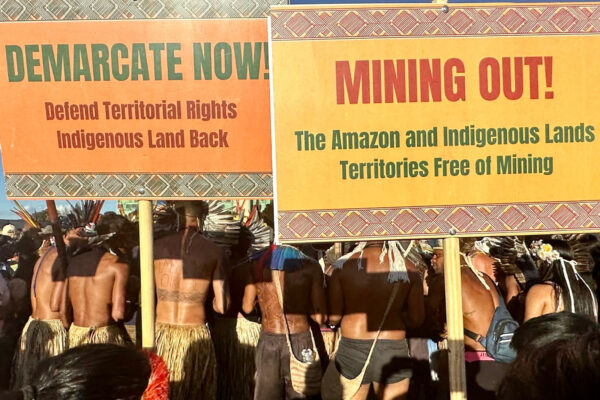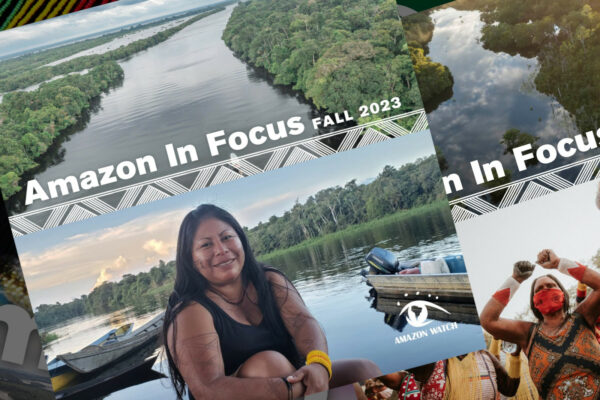By: Christian Poirier, Amazon Watch Brazil Program Coordinator
Along the banks of Brazil’s Madeira River, the rusty remnants of the Madeira-Mamoré railroad, built a century ago to run steam engines from Porto Velho to Guajará-Mirim in Bolivia, lay in ruins. Built at great human, environmental, and financial cost, the railway attests to the spectacular failure in introducing appropriate infrastructure to a fragile and complex environment. Unfortunately the lessons of the Madeira-Mamoré have been lost on Brazil’s eager infrastructure planners, and their shortsighted vision for the region is surely destined to see history repeat itself.
Just upriver from the old Porto Velho railway station, the Santo Antonio dam, under furious construction since 2008, represents another dramatic attempt to bring “development” to the Southwestern Amazon while overlooking critical social and environmental concerns. Santo Antonio is one of two hydroelectric dams currently under construction on the Madeira River, the principal tributary to the Amazon. Planned to consist of four dams and a series of navigation locks reaching into neighboring Bolivia, the Madeira River Complex mega-project is the key component of the Initiative for the Integration of Regional Infrastructure in South America.
See photo gallery from the Madeira here.
The Madeira dams are the latest in a long string of environmentally destructive colonization projects to descend on Brazil’s Rondônia state. Each project brings an influx of migrants and the Madeira dams are no exception: approximately 1,000 new inhabitants are said to arrive in Porto Velho each week, lured by the promise of employment opportunities. These numbers are sure to multiply as these dams dislodge riverbank communities, relocating these development refugees to the margins of Porto Velho. As the city’s health and education infrastructure descend into crisis, further population pressure does not bode well for the future of the state. While the Brazilian government, parastatal companies, and the National Development Bank have made enormous investments in the dams, they appear less concerned with the urgent and basic needs of the state’s population.
A short distance from the swelling bustle of Porto Velho the peaceful riverine village of Teotônio feels locked in time. Teotônio is located on a series of rapids teeming with diverse fish species that provide the villagers with simple livelihoods and food security. Such rapids are common on the Madeira, making the river impossible to navigate above Porto Velho; the dams will flood these navigational impediments, permanently altering the river’s fragile ecosystem. By doing so, the Madeira dams will not only tear apart the social fabric of these traditional communities, but will devastate fish stocks, Rondônia’s principal source of nutrition.
For the indigenous Oro Wari people who live on a tributary to the Madeira, the dam represents not only an assault on their way of life, but to their survival. As local leader Eleazar Oro Wari affirmed, “We were not consulted. If they build this dam how will we cope without fish? This is not the company’s river – they can’t come here to make money. We have been here for many years and we need the fish that live in this river.” That the common goods of the Madeira basin are being privatized for the benefit of a handful of beneficiaries is hard to refute. Those whose lives depend on these waters stand to endure only the negative impacts of the dams.
It is common for riverine communities receive little or no consultation, let alone compensation, from the government or the consortiums responsible for the dams. And where these people have opposed plans for resettlement, allying themselves with popular resistance such as the Movement of People Affected by Dams, the government has responded with insidious intimidation tactics and coercion. If the dams were truly for the benefit of the Brazilian people, why would a democratic government need to resort to these tactics?
In the community of Nueva Esperanza on the Bolivian side of the Madeira the impending impacts of the Jirau dam, second of the two dams currently under construction, are met with incredulity and anger. As community leader Maria Rodriguez Bustamante said in frustration, “the Brazilian government tells us that the flooding will not affect the Bolivian side of the river. We know this is nonsense – water doesn’t respect national borders! If our village is flooded where will we go? We are human beings and need to be treated with dignity and respect.” Respect for Bolivia’s riverine communities, and by extension the country’s sovereignty, appear to have already been submerged under Brazil’s reckless commitment to the Madeira River Complex.
The Madeira dams have been likened to an “atomic bomb” by the environmentalist blogger Telma Monteiro: “the dams are like a bomb’s ground zero sending out waves of destruction in the Amazon such as land occupations and vast deforestation, propagating critical environmental stresses. The Amazon is fragile and only needs a single mega-project to unleash this destruction.” While the lessons of the Madeira-Mamoré railway have been lost, the consequences of Brazil’s current plan for the Madeira basin will greatly eclipse this earlier failure in its potential to bring social and ecological ruin to the region.













